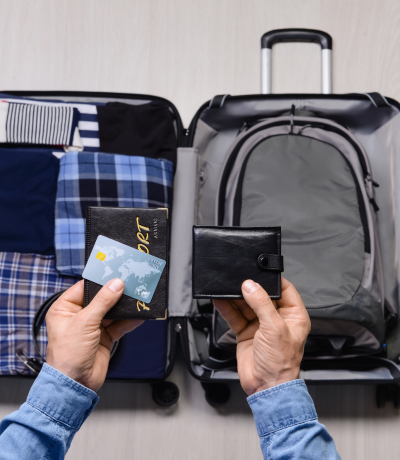What is an RFID wallet and do you need one?
15 March 2024
On a trip, there are some items – like your phone, passport, and wallet – that you really just can’t lose. Those same items are also the ones that you often put in easy reach, in a pocket, purse, or backpack, and pull out frequently, to get through security, pay for things, and check maps.
Pickpocketing is already a real concern for travelers (heck, commuters are concerned about pickpockets). So, if would cause a lot of headaches if you lost it, sure, you want to protect it.
If you’re doing any kind of research before a trip and see ads for RFID-blocking wallets, you may be wondering if that’s the sure bet. The thing that will keep your credit cards safe once and for all.
We dived into this topic this week because I noticed a plethora of articles on RFID and wanted to get to the bottom of the story.

What is RFID really?
The acronym RFID stands for radio frequency identification, and it’s been around since the 1970s. It’s a technology that uses radio waves to identify important things, and the critical thing to realize is that you’re already carrying it.
Any card you have in your wallet right now with the wavy sign on it is an RFID-enabled card. You’ve been using RFID for a while now for anything with contactless functionality: credit cards, car keys, hotel key cards, toll passes, passports, down to the tag hanging on your pet’s collar.
How does RFID work?
RFID chips are embedded in things to enable contactless transactions. When you hold your credit card up to an RFID reader, the reader collects that tiny amount of data in the chip: 64 bits of data, to be exact.
Essentially the data in any RFID chip can be read with an RFID reader if the chip is held close enough.
Since RFID readers are readily available online, and anyone with the money can buy one, you might think that it’s super easy for anyone to stand near you and scrape your data without your consent or knowledge.
That’s true technically, but it’s not something to panic about.
Can an RFID wallet protect my data?
The short answer is sort of.
In practice, an RFID-blocking wallet, purse, or passport holder is engineered with thin metal that blocks the radio signal from being read. That means you’ll have to take it out of its protection to use it, which is the same thing you’d have to do anyway.
Additionally, an RFID reader has to get really close to the chip to be able to read it, so a malicious thief would have to be willing to snuggle quite close and operate in public waving around a relatively large device―it’s not likely.
How do contactless cards work?
Today’s contactless cards are encrypted – this is why they work so well. When you hold it up to a reader, the data is encrypted as it transmits.
Today’s cards also do not transmit any information that could be captured without inserting it into a reader.
Essentially RFID crime is rare. In most cases, when someone’s card has been compromised in this way, the scenario involves the person pulling their card out of their wallet to use it anyway (like at a gas station).
What is an RFID-blocking wallet?
An RFID-blocking wallet uses an electromagnetic shield, essentially a thin metal (like tin foil), to keep your contactless cards hidden from readers. Yes, RFID scanners can’t read the data stored in your cards when they are in this type of wallet.
Still, if you have to remove the card from the wallet to use it, it’s only protected inside the wallet, where most thieves wouldn’t be able to read it with an RFID device anyway.
There are so many ways your credit card information can be stolen, RFID skimming is just not that common.
A really cautious traveler might say: “Well, just in case I’m standing in packed crowds, I’ll get one.”
And that would be fine, especially if you need a new wallet anyway 😏
A better alternative to RFID-blocking?
There are many ways to protect your credit cards, including:
- Mobile wallets: according to the Identity Theft Resource Center, this is the best way to protect your digital cash.
- Watching for social engineering: tricks a hacker uses to get your personal data, like impersonating the police, for example.
- Proactive monitoring of your credit card account and credit reports.
Honestly, if you really want to protect your card (maybe that backup card in your suitcase), wrap it in tin foil.
The bottom line
RFID skimming isn’t worth the effort to thieves. It’s time-consuming, risky, and a hit-or-miss proposition – none of which are attractive to a thief. It’s easier, quicker, and cheaper for thieves to steal huge quantities of credit card numbers through internet scams than trying to chase a traveler around Rome with a skimming device.
Credit cards come with better fraud protection than debit cards, and in the case that your card number is stolen, the recovery process of a replacement card and the financial damage is much easier.
For travelers, that means:
- Pay with a credit card
- Have a backup credit card in case the first one is compromised
- Keep some local cash on hand too
RFID blockers are vastly overhyped marketing tricks to get you to buy an expensive wallet solely for this capability.
Related topics
Damian Tysdal is the founder of CoverTrip, and is a licensed agent for travel insurance (MA 1883287). He believes travel insurance should be easier to understand, and started the first travel insurance blog in 2006.
